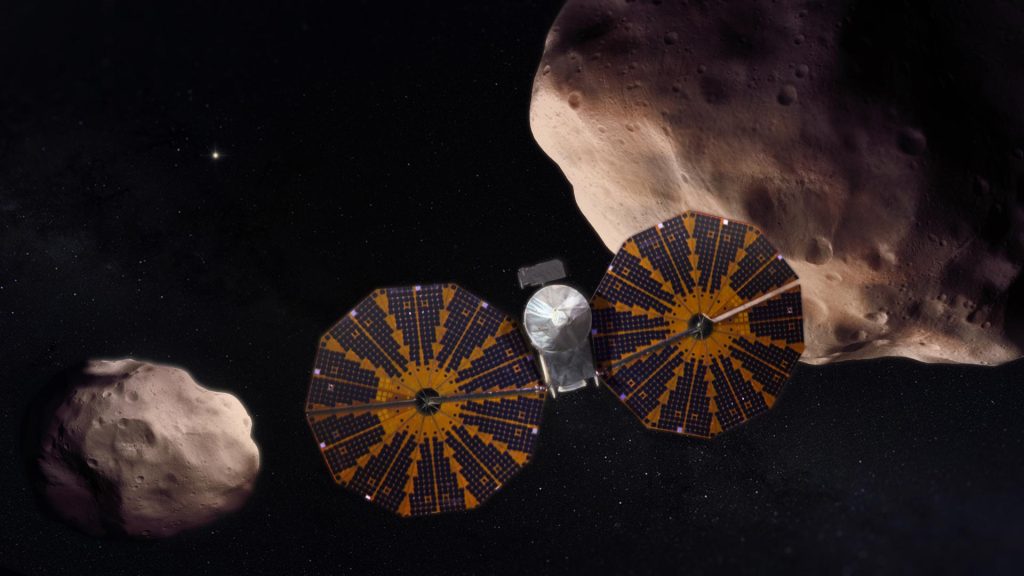

Lucy explorará os asteróides troianos de Júpiter – que se acredita serem “fósseis da formação de planetas”. Crédito: Goddard Space Flight Center da NASA
mesmo antes disso liberar Em outubro de 2021,[{” attribute=””>NASA’s Lucy mission was already on course to break records by visiting more asteroids than any previous mission. Now, the mission can add one more asteroid to the list, after a surprise result from a long-running observation campaign.
Lucy’s science team discovered on March 27 that the smallest of the mission’s Trojan asteroid targets, Polymele, has a satellite of its own. On that day, Polymele was expected to pass in front of a star. This would allow the team to observe the star blink out as the asteroid briefly blocked, or occulted, it. The Lucy team planned to measure the location, size, and shape of Polymele with unprecedented precision while it was outlined by the star behind it. To do so, they spread 26 teams of professional and amateur astronomers across the path where the occultation would be visible.

A graphic showing the observed separation of asteroid Polymele from its discovered satellite. Credit: NASA’s Goddard Space Flight Center
These occultation campaigns have been enormously successful in the past, providing valuable information to the mission on its asteroid targets, but this day would hold a special bonus.
We were thrilled that 14 teams reported observing the star blink out as it passed behind the asteroid. However, as we analyzed the data, we saw that two of the observations were not like the others,” said Marc Buie, Lucy occultation science lead at the Southwest Research Institute, which is headquartered in San Antonio. “Those two observers detected an object around 200 km (about 124 miles) away from Polymele. It had to be a satellite.”

A graphic showing the observed separation of asteroid Polymele from its discovered satellite. Credit: NASA’s Goddard Space Flight Center
Using the occultation data, the scientists determined that this satellite is roughly 3 miles (5 km) in diameter, orbiting Polymele, which is itself around 17 miles (27 km) along its widest axis. The observed distance between the two bodies was approximately 125 miles (200 km).
Following planetary naming conventions, the satellite will not be issued an official name until the team can determine its orbit. As the satellite is too close to Polymele to be clearly seen by Earth-based or Earth-orbiting telescopes – without the help of a fortuitously positioned star – that determination will have to wait until Lucy approaches the asteroid in 2027, unless the team gets lucky with future occultation attempts before then.
At the time of the observation, Polymele was 480 million miles (770 million km) from Earth. Those distances are roughly equivalent to finding a quarter on a sidewalk in Los Angeles – while trying to spot it from a skyscraper thousands of miles away in Manhattan.

Using the occultation data, the team assessed that this satellite is roughly 3 miles (5 km) in diameter, orbiting Polymele, which is itself around 17 miles (27 km) along its widest axis. The observed distance between the two bodies was about 125 miles (200 km). Credit: NASA’s Goddard Space Flight Center
Asteroids hold vital clues to deciphering the history of the solar system – perhaps even the origins of life. Solving these mysteries is a high priority for NASA. The Lucy team originally planned to visit one main belt asteroid and six Trojan asteroids, a previously unexplored population of asteroids that lead and follow Jupiter in its orbit around the Sun. In January of 2021, the team used the Hubble Space Telescope to discover that one of the Trojan asteroids, Eurybates, has a small satellite. Now with this new satellite, Lucy is on track to visit nine asteroids on this remarkable 12-year voyage.
“Lucy’s tagline started out: 12 years, seven asteroids, one spacecraft,” said Lucy program scientist Tom Statler at NASA Headquarters in Washington. “We keep having to change the tagline for this mission, but that’s a good problem to have.”
Em 9 de janeiro de 2020, a missão Lucy anunciou oficialmente que visitaria não sete, mas oito asteroides. Acontece que Eurybates, um dos asteróides ao longo do caminho de Lucy, tem um pequeno satélite. Pouco depois que a equipe de Lucy descobriu o satélite, ela e Eurybates se moveram para trás do sol, impedindo a equipe de observá-lo ainda mais. No entanto, os asteroides apareceram por trás do sol em julho de 2020 e, desde então, a equipe de Lucy conseguiu observar o satélite com o Hubble em várias ocasiões, permitindo que a equipe determinasse com precisão a órbita do satélite e, finalmente, permitindo que o pequeno satélite ganhasse acesso. Nome oficial – Quetta.
O investigador principal de Lucy trabalha em Boulder, Colorado, uma filial do Southwest Research Institute, com sede em San Antonio, Texas. O Goddard Space Flight Center da NASA em Greenbelt, Maryland, oferece gerenciamento abrangente de missões, engenharia de sistemas, segurança e garantia de missões. A Lockheed Martin Space Corporation de Littleton, Colorado construiu a espaçonave. Lucy é a décima terceira missão do Programa de Descobertas da NASA. O Marshall Space Flight Center da NASA em Huntsville, Alabama, gerencia o programa de descoberta para o Science Mission Directorate da agência em Washington.

“Encrenqueiro. Viciado em mídia social. Aficionado por música. Especialista em cultura pop. Criador.”




More Stories
Inspetor Geral da NASA emite relatório contundente sobre atrasos no projeto de lançamento da espaçonave SLS
Uma vaca marinha pré-histórica foi comida por um crocodilo e um tubarão, segundo fósseis
Nova pesquisa sobre uma enorme falha de impulso sugere que o próximo grande terremoto pode ser iminente